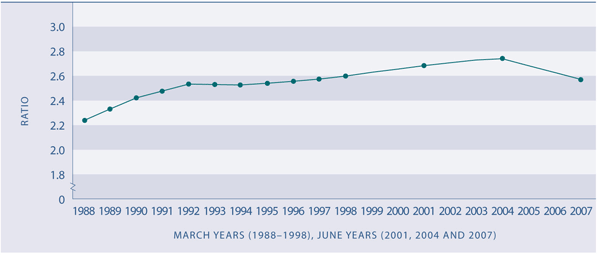Income inequality
Definition
The extent of disparity between high income and low income households.
The measure used is the ratio of the 80th percentile to the 20th percentile of the equivalised disposable household income distribution (ie the ratio of a high household income to a low household income, after adjusting for household size and composition). The higher this ratio, the greater the level of inequality.
Relevance
The degree of income inequality is often regarded as an important aspect of the fairness of the society we live in. A high level of income inequality may also be detrimental to the level of social connectedness across society.
Current level and trends
In 2007, the equivalised disposable income of a household at the 80th percentile was 2.6 times larger than that of a household at the 20th percentile, a decrease from 2.7 times larger in 2004. In 1988, the ratio was 2.2. Income inequality rose between 1988 and 1991, briefly plateaued, then rose again from 1994 to 2004.
Most of the observed increase in income inequality between 1988 and 2004 was due to a larger overall rise in incomes for those in the top 20 percent of incomes – around a quarter once adjustments for inflation are made. In that period, incomes for those in the bottom 20 percent of incomes decreased a little. Incomes for the middle 60 percent climbed more overall for those closer to the top 20 percent than for those closer to the bottom 20 percent.
From 2004 to 2007, incomes for households in the low to middle income range grew strongly, whereas incomes for the top 40 percent grew by only 2 percent to 4 percent in real terms. This led to the decline in the 80:20 percentile ratio from 2004 to 2007.
Figure EC2.1 Ratio of the 80th percentile of equivalised disposable household income to the 20th percentile of equivalised disposable household income, 1988–1998, 2001, 2004 and 2007

Source: Derived from Statistics New Zealand's Household Economic Survey (1988–2007), by the Ministry of Social Development
Notes: (1) Since 1998, the Household Economic Survey has been conducted on a three-yearly basis, rather than annually (2) This measure adjusts for household size and composition
International comparison
Comparisons with other OECD countries are available using a different measure, the Gini coefficient.61 Gini coefficients measure income inequality, with a score of 100 indicating perfect inequality and a score of 0 indicating perfect equality. The most recent OECD comparison (from 2004) gives New Zealand a score of 34, indicating higher inequality than the OECD median of 30 and a ranking of 23rd equal out of 30 countries. The New Zealand Gini score was below that of the United States (38), the same as that of the United Kingdom (34), and slightly above those of Australia (30), Canada (32) and Ireland (33). Denmark and Sweden had the lowest income inequality with Gini scores of 23.62 The 2007 Gini score for New Zealand was still 34.
|

